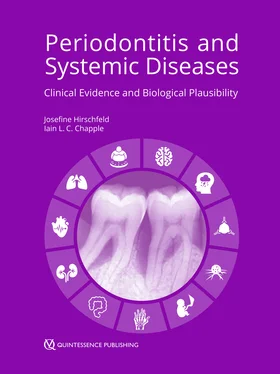1.2.2.3 Association between periodontitis and DM
The relationship between periodontitis and diabetes has been a subject of several longitudinal and interventional studies and it has been suggested that their relationship is bidirectional in both T1DM and T2DM and periodontal diseases 62. For example, in diabetes, local inflammatory reactions within the periodontal tissues are modulated by the associated metabolic dysregulation (i.e. tissue responses to inflammatory stimuli are enhanced in poorly controlled diabetes) 63, which is explained in further detail in Section 1.3 ‘Cellular and molecular mechanisms’.
Epidemiological studies
Diabetes and periodontitis are chronic inflammatory diseases that have been considered to be biologically linked. Diabetes is known to be a primary risk factor for periodontitis, and periodontitis is considered as the sixth complication of DM 25. Evidence linking periodontitis and diabetes began to emerge in the 1990s from several studies conducted in the Pima Indian population in the United States 64. Cross-sectional studies showing the prevalence and longitudinal studies showing the incidence of diabetes, demonstrate that periodontitis is significantly more abundant in subjects who have T1DM 65or T2DM 66diabetes, with a higher risk of having the severe forms of periodontitis. The risk of periodontitis is approximately three to four times higher in people with T2DM than in non-diabetes subjects 67. The direct relationship between the glucose level and the severity of periodontitis has been demonstrated, with the ORs in T2DM patients of periodontal destruction being 1.97 in well, 2.10 in moderately, and 2.42 in people with poorly controlled diabetes 68. In addition, data from the NHANES show that individuals with diabetes are at greater risk for incident and prevalent periodontitis and have more severe periodontitis than individuals without diabetes, after controlling for age, education, smoking status and calculus 69. These data were also supported by a recent meta-regression analysis of longitudinal studies, which included 13 studies. The authors reported that diabetic subjects present a 70% higher incidence or progression risk of periodontitis than non-diabetics (relative risk [RR] 1.86, 95% CI 1.3 to 2.8), despite of high heterogeneity between studies 70. Similarly, a 2019 Taiwanese large-scale cohort study, including 39,384 patients with new-onset diabetes and 39,384 subjects without periodontitis, found that patients with diabetes had a higher risk for periodontitis compared with the patients without diabetes (adjusted hazard ratio 1.04, 95% CI 1.01 to 1.08). As a major shortcoming, however, periodontitis was poorly defined, using ICD-9-CM (International Classification of Diseases, Ninth Revision, Clinical Modification) codes only 71. Conversely, a systematic review and meta-analysis of 12 intervention studies (follow-up period: 6 months) published in the same year, stated that there was no significant difference in pocket reduction or clinical attachment gain between periodontitis patients and those with both diabetes and periodontitis. Furthermore the level of HbA1c at baseline did not affect the difference in pocket reduction. However, this study pooled data from smokers and non-smokers, which is likely to have affected treatment outcomes and therefore the results of this meta-analysis. Furthermore, heterogeneity of the included studies with regard to periodontal diagnosing as well as the relatively short follow-up period may have impacted the results 72.
SUMMARY
● In 2015, it was estimated that 415 million people worldwide have diabetes.
● By 2040, an increase to 642 million is expected.
● The estimated costs associated with diabetes in the United States in 2002 were US $132 billion.
● Intense glycaemic control in both T1DM and T2DM can decrease the morbidity and mortality.
● For every percentage point decrease in HbA1c, there are:
– 35% reduction in the risk of microvascular complications,
– 25% reduction in diabetes-related deaths,
– 7% reduction in all-cause mortality,
– 18% reduction in combined fatal and nonfatal myocardial infarction.
On the other hand, there is evidence for periodontitis promoting the development of diabetes. Overall, six studies with a total sample of 77,716 participants from the United States, Japan and Taiwan demonstrated that patients with periodontitis exhibit a higher chance of developing pre-diabetes and diabetes 2. One of these studies demonstrated that systemically healthy subjects with probing depths equal to or greater than 6 mm have a 3.45 times higher risk of developing diabetes than those without periodontitis 73. Another study demonstrated that subjects with gingivitis have a 40% elevated risk, subjects with periodontitis a 50% elevated risk, and subjects who are partially edentulous a 70% elevated risk of developing T2DM. It is important to mention that this association was observed in non-smoking subjects with normal weight 74. This association can also be seen for gestational DM 75. Furthermore, a recent (2019) study was conducted in 139 periodontitis patients, which employed chair-side screening for HbA1c levels and considered BMI, waist circumference and periodontal parameters. It was found that almost 25% of the subjects had unknown hyperglycaemia and those with HbA1c ≥ 5.7% displayed higher proportions of sites with clinical attachment loss > 5 mm 76.
One recently published longitudinal study followed 2047 subjects aged 20 to 81 years from the Study of Health in Pomerania cohort over a period of 11 years. Although the study was well conducted and excluded many potential biases, it reported no association between periodontal parameters and either diabetes incidence or long-term changes in HbA1c. One shortcoming of this study may be, however, that diabetes was assessed by different methods (self-reporting or antidiabetic medication intake or HbA1c levels or fasting blood glucose) 77.
Moreover, the majority of the studies report an association between worse periodontal conditions and diabetes complications. For example, Shultis et al 78observed that moderate and severe periodontitis, as well as edentulousness, significantly predicted both macroalbuminuria (2.0, 2.1 and 2.6 times higher, respectively) and end-stage renal disease in a dose-dependent manner among Pima Indians with T2DM. In this population, as shown by another study, those with severe periodontitis had a 3.5 times higher risk for cardiorenal death; moreover, nephropathy and death from ischaemic heart disease were significantly predicted by periodontitis 79. In a systematic review and meta-analysis of 27 epidemiological studies, Ziukaite et al 80observed that the prevalence of diabetes was 13.1% among subjects with periodontitis and 9.6% among subjects without periodontitis. Interestingly, for subjects with periodontitis, the prevalence of diabetes was 6.2% when diabetes was self-reported, compared to 17.3% when diabetes was clinically assessed. According to this study, the highest prevalence of diabetes among subjects with periodontitis was observed in studies originating from Asian countries (17.2%) and the lowest in studies describing populations from Europe (4.3%). The overall OR for patients with diabetes among those with periodontitis was 2.27, compared to those without periodontitis. However, there was a substantial variability in the definitions of periodontitis, a combination of self-reported and clinically assessed diabetes, and a lack of assessment of confounding for diabetes in the included studies, introducing estimation bias 80.
Nevertheless, according to Graziani et al 2, periodontitis has an impact on diabetes control, including its incidence and complications. Poor glycaemic control and a higher risk of developing diabetes are observed in systemically healthy individuals with periodontitis. Diabetic individuals with periodontitis demonstrate a worsening of glycaemic control and significantly higher prevalence of diabetes-related complications. For example, patients with T2DM and comorbid periodontitis have significantly more cardiorenal complications (OR 3.5, 95% CI 1.2 to 10.0) 81, neuropathic foot ulcerations (OR 6.6, 95% CI 2.3 to 18.8) 82, cardiovascular complications (OR 2.6, 95% CI 1.6 to 4.2) 83and overall mortality (RR 1.51, 95% CI 1.11 to 2.04 for each 20% increment in mean whole-mouth alveolar bone loss) 84. However, the studies suffered from intrinsic limitations that render the overall applicability of the results weak. For example, some of the evidence was indirectly drawn from manuscripts that did not have the primary intention of assessing the effect of periodontitis on glycaemic control. In addition, there is heterogeneity in terms of adjustment of confounders as well as of the definitions of periodontitis. Furthermore, the possibilities of selective data reporting and publication bias cannot be excluded 2.
Читать дальше











![John Bruce - The Lettsomian Lectures on Diseases and Disorders of the Heart and Arteries in Middle and Advanced Life [1900-1901]](/books/749387/john-bruce-the-lettsomian-lectures-on-diseases-and-disorders-of-the-heart-and-arteries-in-middle-and-advanced-life-1900-1901-thumb.webp)
